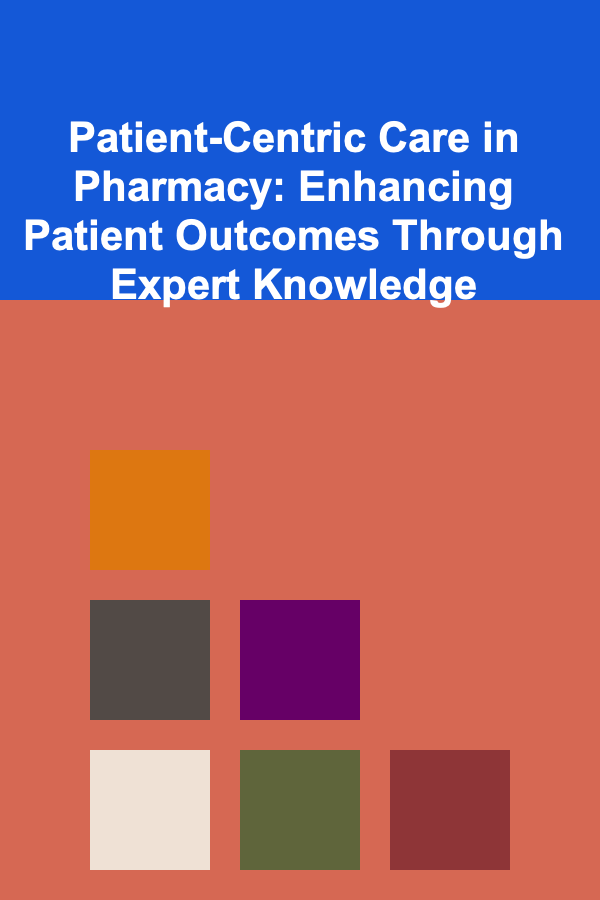
Patient-Centric Care in Pharmacy: Enhancing Patient Outcomes Through Expert Knowledge
ebook include PDF & Audio bundle (Micro Guide)
$12.99$6.99
Limited Time Offer! Order within the next:

In the healthcare landscape, patient-centric care has become a cornerstone of effective treatment, particularly in pharmacy practice. The shift from a purely transactional model---where pharmacists mainly focus on dispensing medication---to a more holistic, patient-centered approach represents a fundamental evolution in how healthcare professionals interact with patients. By emphasizing individual patient needs, pharmacists can enhance medication therapy outcomes, ensure safer and more effective drug use, and ultimately contribute to improved health outcomes.
This actionable guide explores the importance of patient-centric care in pharmacy practice, the role of pharmacists in promoting better outcomes, and strategies to integrate expert knowledge into patient care for maximum impact.
The Pillars of Patient-Centric Care in Pharmacy
Patient-centric care in pharmacy practice revolves around focusing on the patient as a whole person rather than just a consumer of medications. It involves understanding the individual's needs, preferences, and lifestyle while ensuring that pharmaceutical care supports and enhances their overall well-being.
1. Understanding the Patient's Context
Every patient is unique, and an effective pharmacist must assess more than just their medical condition and prescribed medications. Understanding a patient's lifestyle, social determinants of health, and personal preferences plays a significant role in providing care that meets their individual needs.
Actionable Tactics:
- Conduct Comprehensive Patient Interviews: In addition to reviewing medical records, engage patients in open-ended conversations about their daily routines, medication habits, and challenges they may face in adhering to their treatment plan. This information can help tailor interventions that resonate with the patient's reality.
- Address Social Determinants of Health (SDOH): Take into account factors such as income, access to healthcare, housing stability, and education. These elements can significantly influence a patient's ability to adhere to treatment or access necessary medications. Pharmacists can collaborate with other healthcare providers to address these barriers where possible.
- Cultural Competence: Acknowledge and respect cultural differences that may affect a patient's health beliefs, practices, and treatment preferences. Cultural competence allows pharmacists to better communicate and provide care that aligns with patients' values.
2. Personalizing Medication Therapy Management (MTM)
One of the primary ways pharmacists contribute to patient outcomes is through Medication Therapy Management (MTM). MTM goes beyond dispensing medications and includes reviewing a patient's entire medication regimen to optimize therapy, prevent adverse effects, and address any potential drug-related problems.
Actionable Tactics:
- Conduct Comprehensive Medication Reviews (CMRs): Regularly assess patients' medication regimens to identify potential drug interactions, duplications, or inappropriate therapies. Work with patients to ensure they understand their medications and are following the prescribed regimen.
- Customized Interventions: For patients with multiple chronic conditions, pharmacists can adjust therapy to meet individual needs. For example, a diabetes patient who is also hypertensive may require a different medication regimen than someone with only one condition.
- Set Therapeutic Goals: Collaborate with patients and other healthcare providers to set clear, measurable goals for therapy, such as blood pressure targets or blood sugar control. Regular follow-up is crucial to assess progress toward these goals.
3. Promoting Medication Adherence
Non-adherence to medication regimens is a common issue in patient care, which can result in poor health outcomes and unnecessary hospitalizations. Pharmacists play a pivotal role in identifying barriers to adherence and finding personalized solutions to improve it.
Actionable Tactics:
- Assess Adherence Challenges: Ask patients directly about their ability to stick to their medication regimen. Some may have difficulty remembering, others may find the cost of medications prohibitive, and some may experience side effects that deter them from taking their meds.
- Offer Solutions for Common Barriers: For patients with financial concerns, pharmacists can recommend generic medications, patient assistance programs, or alternative therapies. For patients struggling with complex regimens, suggest pill organizers, medication reminders, or digital health apps.
- Motivational Interviewing: Use motivational interviewing techniques to help patients explore and resolve ambivalence about adhering to their treatment. This patient-centered approach fosters a collaborative conversation that empowers the patient to take charge of their health.
4. Engaging in Patient Education
Education is one of the most powerful tools pharmacists have in improving patient outcomes. Well-informed patients are better equipped to make decisions about their care, avoid medication errors, and understand the importance of their treatment plan.
Actionable Tactics:
- Simplify Complex Medical Information: Use plain language and clear explanations to ensure patients understand their treatment plans. Avoid medical jargon and focus on the "why" behind each aspect of their care (e.g., why a specific medication is prescribed, how it works, and potential side effects).
- Visual Aids and Demonstrations: When explaining how to take a medication (e.g., using an inhaler or administering insulin injections), provide visual aids and hands-on demonstrations. This practical guidance can improve a patient's confidence in managing their medications independently.
- Teach About Medication Safety: Make sure patients understand the potential side effects and interactions of their medications, as well as how to properly store and dispose of medications. Patients should know when to seek help if they experience adverse reactions.
5. Building Trust and Empathy
A strong, trusting relationship between the pharmacist and the patient is essential to the success of patient-centered care. When patients trust their pharmacist, they are more likely to share relevant information, follow recommendations, and feel supported in their healthcare journey.
Actionable Tactics:
- Active Listening: Practice active listening during patient interactions. Pay attention to verbal and non-verbal cues to understand not only what the patient is saying but also how they feel about their treatment.
- Empathetic Communication: Show empathy and understanding, especially when patients are frustrated or anxious. Acknowledge their concerns and collaborate with them to find the best solutions. Being present and attentive helps build rapport and trust.
- Confidentiality and Respect: Ensure that patient privacy is maintained and that all interactions are respectful. This will foster a sense of safety and openness, which is crucial for effective patient care.
The Role of Technology in Patient-Centric Pharmacy
Technology can be an invaluable tool for enhancing patient care, improving medication safety, and streamlining pharmacy operations. By integrating modern technological solutions, pharmacists can better support patients while focusing on their individual needs.
1. Electronic Health Records (EHR) Integration
EHR systems provide pharmacists with a comprehensive view of a patient's health history, allowing them to make more informed decisions and avoid medication errors. By accessing up-to-date information, pharmacists can assess potential drug interactions, allergies, and contraindications in real-time.
Actionable Tactics:
- Collaborate with Prescribers: Use the information in EHRs to communicate directly with prescribing physicians. This collaboration can help adjust treatment plans if issues arise.
- Monitor Patient Progress: EHRs allow pharmacists to track changes in a patient's health status, ensuring they remain on the right path to achieving their therapeutic goals.
2. Medication Management Apps and Digital Tools
Digital tools, such as mobile health apps, can empower patients to manage their medications more effectively. Pharmacists can recommend apps that send medication reminders, provide information about side effects, or offer personalized medication advice.
Actionable Tactics:
- Recommend Health Apps: Suggest patient-friendly apps that track medications, remind patients about refills, and provide educational content about their prescriptions.
- Virtual Care and Telehealth: Embrace virtual consultations to support patients remotely. Telehealth has become increasingly popular, allowing pharmacists to provide consultations and follow-ups even in rural or underserved areas.
Collaborative Care: Pharmacists as Healthcare Team Members
Patient outcomes are often best achieved through collaborative care, where pharmacists work alongside physicians, nurses, and other healthcare professionals. This integrated approach ensures that all aspects of the patient's health are being addressed, and the treatment plan is holistic and comprehensive.
1. Pharmacist-Physician Collaboration
Pharmacists can provide valuable insights into a patient's medication regimen, alerting physicians to potential issues such as drug interactions or dosing errors. Collaborative care enhances the quality of patient care and improves outcomes by integrating multiple perspectives.
Actionable Tactics:
- Regular Team Meetings: Engage in multidisciplinary team meetings where pharmacists can contribute their expertise on pharmacotherapy and medication management.
- Proactive Communication: Communicate directly with physicians when you identify medication-related problems or opportunities for optimizing therapy. Early intervention can prevent adverse effects or complications.
2. Patient-Centered Healthcare Teams
Collaborating with nurses, dietitians, and other healthcare providers helps create a seamless and well-rounded care experience for patients. Pharmacists can contribute by advising on medication therapy, helping monitor side effects, and suggesting non-pharmacological interventions to complement medication therapy.
Actionable Tactics:
- Coordinate Care Plans: Work with other team members to develop coordinated care plans that ensure the patient receives comprehensive treatment.
- Follow-Up and Monitoring: Collaborate with nurses to monitor patients and track their progress. Pharmacists can assist by evaluating the effectiveness of medications, identifying side effects, and adjusting regimens as needed.
Conclusion
Patient-centric care in pharmacy is about placing the patient at the heart of the healthcare experience. By leveraging expert knowledge, pharmacists can provide individualized care that goes beyond medication dispensing. This approach leads to better patient outcomes, safer medication use, and more meaningful patient-provider relationships.
Through active listening, personalized medication therapy management, patient education, and collaboration with the healthcare team, pharmacists can truly enhance the quality of care and contribute to the overall health and well-being of their patients. In the evolving healthcare landscape, adopting a patient-centered model is not just a best practice---it is essential for optimizing therapeutic outcomes and improving patient quality of life.

How to Create a Checklist for Running Social Media Contests and Giveaways
Read More
How to Understand Lighting and Shadows in Art
Read More
How to Incorporate More Fruits and Vegetables into Your Diet
Read More
How to Choose the Right Gear for Your Extreme Sport
Read More
10 Tips for Preventing Algae Growth in Your Hydroponic System
Read More
10 Tips for Mobile App Localization: Reaching a Global Audience
Read MoreOther Products

How to Create a Checklist for Running Social Media Contests and Giveaways
Read More
How to Understand Lighting and Shadows in Art
Read More
How to Incorporate More Fruits and Vegetables into Your Diet
Read More
How to Choose the Right Gear for Your Extreme Sport
Read More
10 Tips for Preventing Algae Growth in Your Hydroponic System
Read More